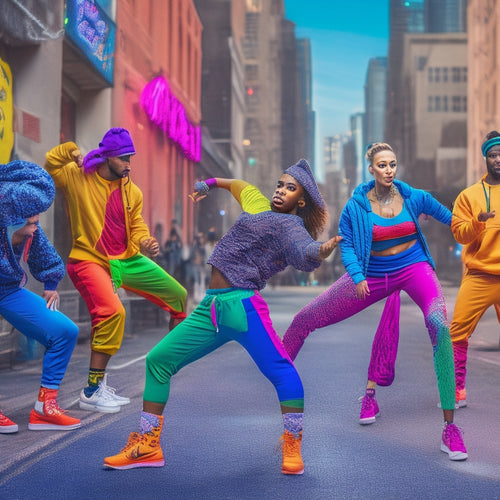
Can You Ballroom Dance on Marley Floor?
Share
You can ballroom dance on a Marley floor, but it's crucial to take into account the floor's shock-absorbing properties and how they'll impact your movements, as well as your own skill level and experience, to guarantee a safe and successful dance session. Marley floors can reduce strain on your joints, but you'll need to adjust your footwork and techniques to maintain control and stability. With practice and patience, you can master the unique demands of dancing on a Marley floor - and discover the benefits it can bring to your dancing. Now, explore the specifics of ballroom dance styles, floor types, and safety considerations to elevate your Marley floor dancing experience.
Key Takeaways
• Yes, you can ballroom dance on a Marley floor, which is designed for shock absorption and reduces strain on joints.
• Marley floors are suitable for various ballroom dance styles, but adaptations may be necessary for high-impact styles.
• Dancer skill level and experience play a crucial role in determining readiness for dancing on Marley floors.
• Different Marley floor types and textures can impact dance moves, with luxury vinyl tile (LVT) options offering benefits.
• Safety considerations, such as slip hazards and proper footwear, are essential when ballroom dancing on Marley floors.
Understanding Marley Floors
Before you step onto the dance floor, it's important to grasp the unique characteristics of Marley floors, which are specifically designed to provide a springy, shock-absorbing surface that reduces the impact on dancers' joints.
As you prepare to dance, it's vital to understand the Marley history and how it has evolved over time. The floor's evolution is a result of innovative materials and design, creating a surface that's both durable and comfortable.
You'll appreciate the floor's ability to absorb shock, reducing the strain on your joints as you move across the dance floor. With this knowledge, you'll be able to focus on your technique, confident that the Marley floor will support your every step.
Ballroom Dance Styles and Challenges
As you get ready to take the floor, you'll want to contemplate how different ballroom dance styles will interact with the Marley floor.
You'll need to adjust your footwork to compensate for the floor's unique characteristics, and understanding the limitations of each style will be key to a successful performance.
Dance Style Limitations
What specific dance style limitations might you encounter on a Marley floor, and how can you adapt your ballroom dance techniques to overcome them?
As you take to the Marley floor, you may find that certain dance styles, like the dramatic arm movements in Paso Doble or the quick footwork in Viennese Waltz, can be challenging. However, with practice and patience, you can adapt your techniques to overcome these limitations.
Consider incorporating elements of Dance Fusion, blending styles to create a unique expression. This Style Evolution will allow you to explore new movements and push the boundaries of traditional ballroom dance.
Floor Impact Dynamics
Your Marley floor's responsiveness and shock absorption will greatly influence the dynamics of your ballroom dance movements, necessitating adjustments to your technique, particularly in styles that involve high-impact movements or quick directional changes.
As you dance, you'll notice how the floor responds to your movements, affecting your balance, posture, and overall execution. To optimize your performance, consider the following factors:
-
Floor resonance: How the floor vibrates in response to your movements, which can either enhance or hinder your dance.
-
Shock absorption: The floor's ability to absorb impact, reducing the stress on your joints and muscles.
-
Energy transfer: How the floor's responsiveness affects the energy transfer between your body and the floor.
- Body alignment: The importance of maintaining proper body alignment to compensate for the floor's shock absorption and resonance.
Footwork Adaptations
When tackling high-impact ballroom dance styles like Jive or Paso Doble on a Marley floor, you'll need to adapt your footwork to accommodate the floor's responsiveness, ensuring that your movements remain powerful and engaging.
To achieve this, focus on precise heel placement, keeping your heels light and mobile to maintain balance and control. Additionally, prioritize ankle mobility to facilitate quick weight transfers and sharp turns.
As you move, keep your ankles soft and pliable, allowing your feet to respond to the floor's give. By adapting your footwork in this way, you'll be able to harness the energy of the Marley floor, delivering dynamic and enthralling performances.
Dancer Skill Level and Experience
As you prepare to take to the Marley floor, your dancer skill level and experience play a significant role in determining which ballroom dance styles and techniques you can confidently execute.
As a beginner, you may find it challenging to master complex steps, while experienced dancers can tackle intricate movements with ease. To improve your skills, prioritize practice consistency to build muscle memory and reduce performance anxiety.
Consider the following factors to gauge your readiness for Marley floor dancing:
- Your proficiency in basic footwork patterns
- Familiarity with rhythm and timing
- Ability to adapt to different floor surfaces
- Mastery of basic turns and movements
Marley Floor Types and Textures
As you explore the world of Marley floors, you'll discover that the type and texture of the floor surface can greatly impact your ballroom dancing experience.
You'll find that Marley floor surfaces come in various forms, including homogeneous and heterogeneous vinyl dance flooring, each with its unique characteristics and benefits.
Marley Floor Surfaces
Understanding the different options available for your Marley floor's surface texture and type can greatly impact your ballroom dancing experience. When it comes to Marley floor surfaces, you have several options to choose from, each with its unique characteristics.
Here are some key considerations to keep in mind:
-
Texture: Smooth, textured, or embossed surfaces can influence your dance moves, so choose wisely.
-
Slip resistance: Higher slip resistance means more traction, which can enhance your overall performance.
-
Shock absorption: A floor that absorbs shock can reduce fatigue and prevent injuries.
- Maintenance: Some surfaces require more maintenance than others, so consider your Floor Maintenance schedule and Installation Costs when making your decision.
Vinyl Dance Flooring
When selecting a vinyl dance flooring for your Marley floor, you're spoiled for choice between homogeneous, heterogeneous, and luxury vinyl tile (LVT) options, each offering unique textures and benefits that can elevate your ballroom dancing experience.
Homogeneous vinyl, with its uniform composition, excels in vinyl durability tests, ensuring a long-lasting and low-maintenance floor.
Heterogeneous vinyl, with its layered structure, provides a more affordable option without compromising on performance.
LVT, with its realistic designs and textures, can transform your dance studio's aesthetics, creating an immersive environment that inspires creativity and passion.
Safety Considerations and Risks
Engaging in ballroom dance on a Marley floor requires careful attention to potential hazards, since you'll be moving swiftly and closely with your partner. As you sway across the floor, it's vital to be aware of the risks involved.
Here are some key safety considerations to keep in mind:
-
Slip hazards: Marley floors can be slippery, especially when wearing dance shoes with smooth soles. Be cautious of sudden stops or changes in direction.
-
Injuries: With fast-paced movements and close proximity to your partner, injuries can occur. Make sure to stretch before dancing and communicate with your partner about any physical limitations.
-
Floor obstructions: Confirm the dance floor is clear of any obstacles, such as loose wires or protruding objects, to prevent tripping or falling.
- Proper footwear: Wear dance shoes with non-slip soles to reduce the risk of slipping and falling.
Alternatives and Ideal Floor Options
As you take precautions to mitigate the risks associated with dancing on a Marley floor, you may also consider exploring alternative floor options that better suit your ballroom dancing needs.
One ideal option is to opt for dance studios with sprung floors, which provide a cushioned surface that reduces the impact on your joints.
Another alternative is to choose floors made from shock-absorbing materials, such as wood or cork, which can help minimize the risk of injury.
When selecting a dance studio, look for those with floors made from high-quality, durable materials that can withstand heavy use.
Frequently Asked Questions
Can Beginners Learn Ballroom Dance on a Marley Floor?
As you start ballroom dancing on a Marley floor, you'll find that it's a great surface for beginners like you, allowing for flexibility improvement and development of muscle memory, making every step feel more natural and intuitive over time.
How Do I Clean and Maintain a Marley Floor for Dance?
'As you step onto the gleaming Marley floor, imagine the echoes of tapping shoes and whispers of past performances. Now, to keep this sanctuary spotless, you'll daily sweep away dirt and dust, and sanitize the floor to guarantee a healthy, sparkling haven for your dance journey.'
Are Marley Floors Suitable for Wheelchair-Bound Dancers?
You're wondering if Marley floors are suitable for wheelchair-bound dancers? Absolutely! With accessible choreography and adaptive partnering, you can create a safe and inclusive space for all dancers, regardless of ability.
Can I Install a Marley Floor in My Home for Practice?
"As you envision your home transformed into a serene dance haven, you're wondering if a Marley floor can become an integral part of your personal space. Absolutely, you can install one for practice, blending functionality with home decor."
Do Marley Floors Cause Injuries or Long-Term Damage?
When you dance on a Marley floor, you're at risk of floor impact, which can lead to joint strains; however, with proper training, technique, and warm-ups, you can minimize the risk of injuries and long-term damage, ensuring a healthy and fulfilling dance practice.
Related Posts
-

Digital Marketing Strategies for Dance Business Success
You're about to unleash the full potential of your dance business by leveraging digital marketing strategies that wil...
-

Hip Hop Dance Apparel for Style and Function
Hip hop dance apparel combines style and functionality, so you can move with confidence and flair. Look for breathabl...
-

Groove in Your Kitchen With Digital Download
With a digital download, you can instantly transform your kitchen into a vibrant space that reflects your personal st...


